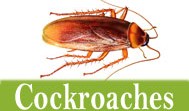
Few insects cause as much concern and distress as cockroaches. As an insect, they are virtually unchanged since prehistoric times and, when they get into our properties,bars,restaurants etc., they are often not spotted until there is an infestation. They thrive in damp,warm areas ,such as fridge motors,under sinks ,worktops and cupboard hinges, to name just a few of there hiding places.
Cockroaches can be difficult to identify to the untrained as they only come out at night. During the day, they hide around door frames, hinges, they will hide in clocks, in the back of televisions, around fridge motors – anywhere!If you are seeing roaches during the daytime, then the infestation could be worse than you can imagine.
They are most likely to be spotted when lights in a dark room are switched on at night. This will send them scurrying back to their safe place. Other signs to look out for are: small dark coloured droppings ,almost like black pepper grains, in the case of German cockroaches, and tiny brown cigar shape droppings in the case of large American roaches. Cockroaches have their own distinctive smell which hits you when entering an infested room. Its not pleasant !!
Cockroaches will eat anything that they can get to. To combat this, good hygiene is a must. Properties need to be properly cleaned, particularly food areas. Good storage methods are also necessary, plastic boxes with lids are essential for foodstuffs.
Minor cockroach infestations can be dealt with without a pest control professional but a professional knows exactly where to look and can save you time and expense by dealing with the infestation quickly and efficiently.
If the problem keeps reoccurring, then it could be a re-infestation from other properties and that’s when a coordinated program of treatment needs to be carried out by a professional in cockroach prevention. We have dealt with cases of German roaches infesting an adjoining apartment by entering via the electrical plug sockets.
FUN FACTS ABOUT COCKROACHES
- A cockroach can live for between one and two weeks without its head. Scientists have found that a decapitated roach will still respond to stimuli by wiggling its legs. Its breathing occurs from spiracles along the sides of its body.
- There are 4,000 species of cockroaches but only about 30 are considered as pests.
- In some parts of the world, cockroaches are profitably raised for chicken feed.
- A cockroach can hold its breath for up to 40 minutes and can survive under water for up to 30 minutes.
- A competitor in a cockroach eating competition in the States,died after choking on bits of cockroach lodged in his throat. His prize would have been a Python !!
- It’s hard to sneak up on a cockroach. They have one great big nerve connecting their tails to their heads, alerting them to air changes that may be danger from behind.
- The running speed of a cockroach is the equivalent of a 100 metres runner doing the distance in 2 seconds. From start to flat out has been timed at 8.2 milliseconds !!
- German cockroaches incubate their eggs in an ooteca attached to their rear. It can contain up to 40 eggs. American roaches push the egg sack into a crack or crevice until it hatches. This can contain around 14 babies.
- A cockroach that has just shed its skin is white and has black eyes. It takes a few hours for the outer skin layer to harden and darken.
- Roaches have been on earth for 350 million years and are considered the most successful creature ever.
